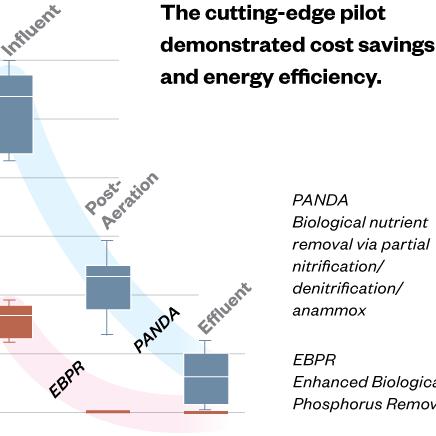In-Tank Carbon Generation as a Primary Benefit of RAS and MLSS Fermentation
Last Modified Jul 01, 2022
Introduction
As effluent nutrient limits get more stringent, water resource recovery facilities (WRRFs) will continue to need to implement biological nitrogen (N) and phosphorus (P) removal. BPR systems in particular are susceptible to upset and many plants struggle to maintain BPR year-round because of a multitude of factors including, insufficient bioavailable carbon for PAOs, suboptimal aeration control, solids recycle impacts, excessive solids retention times, suboptimal pH operation, and secondary phosphorus release.
Recently, it has been suggested that current BPR designs are inadequate for stable performance and that sidestream RAS fermentation is needed for stable BPR (Barnard et al., 2017). The authors propose that RAS fermentation selects for unique BPR organisms (e.g., Tetrasphaera) that can perform anoxic P uptake and also ferment in the presence of deeply anaerobic conditions redox conditions. Barnard et al., 2017 have also suggested that the influent wastewater characteristics can become irrelevant if RAS fermentation is implemented. Interestingly, recent work has shown that the microbial community in conventional BPR systems has less diversity than sidestream RAS or MLSS fermentation systems; however, the functional community (primary organisms responsible for BPR) were similar regardless of configuration (Onniss-Hayden et al., 2019). These authors were also careful to suggest that the “superior” performance of RAS/MLSS fermentation systems may be due to positive bias in their comparison of facilities.
Given these findings, it is still not clear to practitioners what may be driving RAS/MLSS fermentation systems to have stable BPR. This work investigates the underlying reasons for scenarios where implementing RAS or MLSS fermentation as part of a flexible BNR design can help to stabilize BPR. Specifically, this work documents how RAS/MLSS fermentation can be used to ensure that sufficient carbon is provided to a BPR system that is subjected to shifts in wastewater characteristics in response to peak flow conditions and cold temperatures.
Approach
Facility Description Two full-scale WRRFs were examined in this work. The Western Wake Regional Water Reclamation Facility (WWRWRF) uses a modified 5-stage BNR process with a MLSS fermentation zone. Flow is recycled from the end of the anoxic zone to the head of anaerobic zone. There is also a small recycle pump at the end of the anaerobic zone that returns flow to the MLSS fermentation zone. The WWRWRF achieves an effluent TN and TP of 2.0 and 0.2 mg/L, respectively without chemical addition.
The Hominy Creek Water Reclamation Facility (HCWRF) uses a 4-Stage Bardenpho process with a RAS fermentation zone. A portion of RAS is returned to a sidestream anaerobic reactor (SAR) prior to returning to the head of the 4-stage process. The SAR was designed as a four-cell reactor that could accept primary effluent, primary sludge, and/or RAS, but due to seized valves, currently only receives RAS. HCWRF achieves an effluent TN and TP of 2.1 and 0.3 mg/L, respectively with 200 gallons per day (gpd) of MicroC3000 and no metal salt addition.
Field Sampling The MLSS fermentation Zone at the WWRWRF is hypothesized to provide sufficient carbon for PAOs to consistently meet low effluent TN limits with no carbon addition. Field sampling was performed at the facility as documented below:
- Profile sampling was performed across the BNR tanks to characterize nutrients and organic carbon,
- Depth profile sampling in the selector zones was performed to characterize fate of phosphorus and carbon,
- Phosphorus release batch tests were performed to observe carbon uptake and phosphorus release using multiple carbon sources,
- 48-hour fermentation batch tests were performed with anaerobic zone MLSS and re-aeration Zone MLSS to determine how much soluble carbon was released over a 48-hour period using different sludges.
Profile sampling similar to the WWRWRF will be performed in the Spring of 2021 at the HCWRF to determine the performance of the SAR for biological phosphorus removal. Full-scale testing will also be performed to evaluate the optimal configurations and associated HRTs for the SAR. The HCWRF full scale testing and profile sampling will provide insight on the effectiveness of RAS fermentation, and if it can enhance BRP without the use of a dedicated anaerobic zone.
Data analytics Historical data from both facilities were examined to best elucidate long-term trends in performance. Processed data was used to perform single and multilinear regression analyses to identify WRRF environmental and operating parameters that have a causative effect on phosphorus removal.
Insights from Evaluation
The WWRWRF discontinued the use of supplemental carbon and ferric sulfate in July 2016 and May 2018, respectively. Since that time the facility has averaged an effluent TN and TP below 2.0 mg/L and 0.2 mg/L, respectively. Special sampling was performed in the Spring of 2018 to observe nitrogen and phosphorus removal in the BRB basins. Phosphorus release batch tests and 48-hour fermentation batch tests were also performed for the WWRWRF. Results indicated:
- Fermentation is occurring in Cell 1. sCOD and oP is observed. Since phosphorus is being released in Cell 1, the extent to which sCOD and VFA is generated cannot be directly measured due to simultaneous VFA production and uptake by the phosphorus accumulating organisms (PAOs).
- Presence of appreciable sCOD carbon in Cell 1 (not receiving PE) suggests fermentation of mixed liquor to VFAs is present and robust. Phosphorus is rapidly uptaken in the first aerobic zone, suggesting there is a very healthy PAO population.
- Phosphorus release tests indicate the biomass can consume acetic, propionic and butyric acids. Propionic acid had the highest uptake rate in the first 15 minutes while acetic acid had the highest average uptake over the 90 minute test.
- A P:VFA uptake rate of 0.29 mg P Release per mg VFA as COD Uptaken was calculated from the phosphorus release test.
- The 48-hour fermentation tests using the anaerobic zone MLSS solubilized 66 mg of COD/L while the reaeration zone MLSS solubilized 45 mg of COD/L. This indicates that there is additional particulate/colloidal COD in the anaerobic zone MLSS that is fermented to soluble COD.
- The 48-hour fermentation tests also showed a maximum P release after approximately 20 hours using both MLSS sources, but carbon generation increased over the full 48-hour period.










